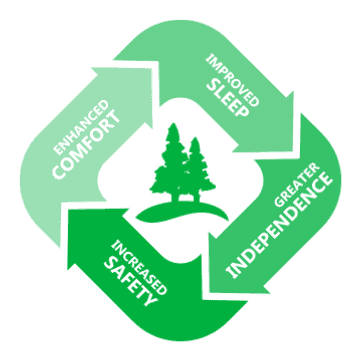Learn About Main Categories of Hospital Beds
| Key Takeaways |
|---|
| ✅ Electric hospital beds offer features like height adjustment, head and foot elevation, side rail controls, and easy mobility for patients with limited mobility. |
| ✅ Semi-electric hospital beds combine manual cranks for height adjustment and electric controls for head and foot elevation. |
| ✅ Manual hospital beds require physical effort to adjust the bed’s height or position. |
| ✅ Low beds sit closer to the ground than standard hospital beds, offering additional safety features. |
| ✅ Hi-low hospital beds can be adjusted to different levels based on the caregiver’s needs. |
| ✅ Acute care beds with low air loss mattresses help prevent pressure sores by using airflow technology to distribute weight evenly over the mattress surface. |
| ✅ Air fluidized beds provide maximum pressure relief by distributing air through silicone beads. |
| ✅ Bariatric beds accommodate larger patients who require more space while sleeping or convalescing. |
Medical conditions or patient requirements dictate the characteristics, advantages, and disadvantages of each category. The following article examines the most popular hospital bed categories on the market.
The purpose of this article is to provide healthcare providers with information about the features and benefits of each hospital bed so they can make an informed decision when purchasing or recommending one. In order to ensure that patients receive the best possible care and stay comfortable and secure during their respite or recovery process, it is essential to understand these different types of hospital beds.
Exploring The Most Popular Hospital Bed Categories
This section provides an overview of the prevalent classifications of hospital beds, which are widely utilized in healthcare settings to cater to different patient needs and promote optimal recovery outcomes. Hospital beds are specialized equipment that play a critical role in the care of patients who require medical attention for various ailments. These beds come in different categories ranging from basic manual models to more advanced electric and air-fluidized options that provide superior comfort and support.
Among the most popular categories of hospital beds are electric beds, semi-electric beds, manual beds, low beds, hi-low beds, acute care with air loss mattresses, clinitron beds, air fluidized beds, and bariatric beds. According to the category, each product is designed to meet a specific patient need, such as mobility limitations or the prevention of pressure ulcers. Patients who require frequent position changes or have difficulty moving around can benefit from electric or semi-electric models.
A low bed model is suitable for patients who may be at risk of falling out of bed due to disorientation or confusion, whereas a high-low option allows you to adjust the bed height electronically. For patients with pressure ulcers or other skin conditions, the air-fluidized and Clinitron models distribute weight evenly across the surface area, ensuring maximum comfort.
Ultimately, the types of hospital beds vary according to the needs of individual patients. It is important to consider factors such as the patient’s mobility limitations and medical condition when choosing a bed. Next, we will discuss electric beds in detail, including their features and benefits over traditional manual beds.
Discover The Category Of Electric Beds
Patients’ comfort, safety, and recovery are improved with the use of electric beds, an innovative type of medical equipment. With the simple push of a button, these beds can be adjusted for height, headrest, footrest, and overall position, making them increasingly popular in hospitals, rehab centers, and long-term care facilities.
Here are three main benefits of electric beds:
1. Beds with electric pressure relief can re-distribute pressure points on the body by adjusting the angle of the surface. For patients with limited mobility or immobility, this feature can prevent pressure ulcers and bedsores.
2. A bed with an electric motor offers greater safety because it is smoother to operate and comes equipped with side rails that can be raised or lowered according to the patient’s needs. In addition to providing support when getting in and out of bed, this feature helps prevent accidental falls.
3. A more comfortable sleeping position can be achieved with electric beds without the need to physically adjust yourself throughout the night. It is also possible for patients to sit up comfortably in bed for meals or activities without straining their backs.
Modern healthcare facilities have become increasingly dependent on electric beds due to their numerous benefits for patients and healthcare workers.
As previously mentioned, semi-electric hospital beds are another popular type of medical equipment. The height of the bed frame can be raised and lowered manually using a hand crank, and headrests and footrests can be adjusted with buttons on a remote control device. When power outages or other emergencies occur, semi-electric hospital beds can still be used manually, as opposed to fully electric ones that need electrical power at all times. Fully electric beds do come with backup batteries and most healthcare facilities are equipped with backup generators.
Beds with semi-electric functions
Providing healthcare professionals with a versatile tool to improve patient care, semi-electric beds combine the advantages of manual and motorized adjustment for patient comfort and safety. For height and head positioning, these beds usually have manual adjustments, while the footrest is usually operated by an electric motor. Patients can elevate their legs without having to manually adjust the bed’s position, which is particularly helpful when they have swelling or injuries.
Healthcare facilities are increasingly using semi-electric beds because of their many benefits. Small clinics and hospitals on a budget can benefit from their cost-effectiveness as compared to fully electric beds. As an added benefit, semi-electric beds allow for easier repositioning of patients without causing discomfort or strain to caregivers. Additionally, they include features such as side rails and brakes to enhance safety.
A semi-electric bed offers healthcare professionals an affordable and versatile option for enhancing patient comfort and care in smaller clinics and hospitals. Patient positions can be adjusted manually and electrically to ensure that caregivers are not uncomfortable or strained. However, the flexibility offered by semi-electric options makes them a popular choice across all types of healthcare facilities despite their limitations. In the next section, we will discuss the unique features of manual beds.
Manually Operated Medical and Hospital Beds
In terms of patient comfort and safety, manual beds offer a basic level of adjustability. A common use for these beds is in hospitals, nursing homes, and other healthcare facilities. The height of a manual bed, as well as the position of the head and feet, are adjusted with hand cranks or levers.
Here are some benefits and features of manual beds:
– Affordable: Manual beds are more affordable than electric or semi-electric options.
– Easy to use: Since manual beds don’t have electrical components, they’re easier to operate and maintain.
– Reliable: Manual beds don’t rely on electricity, so they can be used during power outages or in areas without access to reliable electricity.
– Lightweight: Most manual beds are lightweight, making them easy to move around when necessary.
– Durable: Manual beds can withstand daily use in busy healthcare settings.
Patients still benefit from manual beds even though they are simpler than other hospital bed types. During meals or when interacting with visitors, patients can sit comfortably. During caregiving, caregivers can also raise or lower the bed height as necessary.
It can be argued that manual beds are a reliable, easy-to-use, lightweight, durable, and affordable option for patient care. Despite not being as adjustable as electric or semielectric models, manual hospital beds provide enough comfort and safety for patients who need basic levels of support.
Next, let’s talk about low-bed frames; they are not only lighter than traditional hospital beds, but also safer by reducing falls caused by accidentally rolling out at night for patients who may be disoriented due to medications.
Learn About Beds With Very Low Profiles
Compared to traditional hospital beds, low beds are safer for patients, especially if they are disoriented as a result of medication side effects. Often, these beds come with padded side rails to prevent accidents, and they are designed with a lower height than standard models.
Older adults and those with mobility issues often use low beds in hospitals and care facilities. Comfort and accessibility are two advantages of low beds. In addition to not having to climb up high, patients can enter and exit the bed without difficulty. Patients can rest easier knowing they are not going to have an unexpected accident overnight or be trapped in a certain height positon.
Another advantage of low beds is their ease of use for caregivers. With a lower height, it is easier for caregivers to assist patients with tasks such as changing clothes or administering medications. Low beds provide convenience beyond just assisting patients; they also help reduce caregiver strain and fatigue so that they can effectively perform their duties.
SonderCare offers very low beds with additional features such as built-in lighting systems, adjustable headrests, and easy-to-use remote controls. The company’s focus on innovation ensures that its products meet the evolving needs of healthcare providers while prioritizing patient safety and comfort.
Transition: While low beds serve an important function in improving patient safety and accessibility, there are other types of hospital beds available that offer even more versatility in terms of adjustability–such as hi-low beds.
Understanding The Hi-Low Bed Category
Hi-low beds provide enhanced adjustability for patients and caregivers, allowing for greater ease in transfers, positioning, and overall comfort. These beds are designed with the ability to raise or lower their height to meet the needs of different individuals. The height adjustment feature is especially useful for patients who require assistance in getting in and out of bed as it reduces the risk of falls and injuries.
Hi-low beds typically come with side rails that can be raised or lowered as needed, providing additional safety measures. The benefits of hi-low beds extend beyond patient safety. They also offer convenience for caregivers by reducing strain on their backs when lifting or transferring patients. The adjustable features allow caregivers to find a comfortable working height without having to bend over or reach too far down. This helps prevent fatigue and injury among healthcare providers who spend long hours caring for patients.
Additionally, hi-low beds often come equipped with other features such as built-in scales, headboards, and footboards that make caregiving tasks easier. SonderCare offers hi-low beds that are made from high-quality materials which ensure durability and longevity. Their hi-low beds also have easy-to-use controls that allow patients to adjust the bed’s position with minimal effort. Furthermore, SonderCare provides exceptional customer service and support throughout the entire process from purchase to delivery.
Overall, hi-low beds are an essential piece of equipment in any healthcare setting where patient care is a top priority. With their adjustable features, they provide improved safety and convenience both for patients and caregivers alike. In the next section about acute care beds with low air loss mattresses we will discuss another popular hospital bed category used specifically for pressure ulcer prevention management purposes in acute care settings.
Acute Care Beds with Low Air Loss Mattresses
Patients in acute care settings commonly use acute care beds with low air loss mattresses to prevent pressure ulcers. Patients with these beds benefit from innovative technology that redistributes their weight and relieves pressure points that can cause ulcers. As the mattress is low in air loss, moisture is less likely to accumulate on its surface, maintaining skin integrity.
Comfortable, supportive, and healing, acute care beds with low air loss mattresses provide immense benefits. It is possible to adjust the firmness level of these beds based on the needs of the individual patient, such as changing their positions. To prevent falls or injuries during transfers, they are equipped with safety features such as locking mechanisms and side rails.
Microclimate control systems on these beds regulate temperature and humidity levels around the patient’s body, which is a notable feature. By reducing the discomfort caused by excess heat or cold, this system ensures optimal wound healing conditions.
Patients benefit significantly from acute care beds with low air loss mattresses compared to traditional hospital beds.
The use of beds with low air loss mattresses in acute care settings is an effective method of preventing pressure ulcers. By effectively redistributing weight and managing moisture, they maintain skin integrity while enhancing patient comfort and promoting healing.
Our next section about ‘air fluidized beds’ will explore another type of hospital bed commonly used in specialized medical settings.
What Is The Air Fluidized Beds Category?
Patients with complex medical needs can benefit from air fluidized beds, which use air pressure to create a fluid-like surface. For patients with severe burns or wounds requiring specialized wound care, these beds are commonly used in hospitals and long-term care facilities. A fluidized bed reduces pressure points by circulating heated air through silicone beads, resulting in a surface that conforms to a patient’s body.
In addition to preventing pressure ulcers, air fluidized beds also provide other benefits. The development of pressure ulcers, also referred to as bedsores, can occur as a result of prolonged sitting without changing positions. Air fluidized beds have a fluid-like surface that reduces pressure on the patient’s skin, reducing the likelihood that they will develop pressure ulcers.
Aside from providing improved ventilation and temperature regulation, these beds keep patients comfortable during extended bed rest periods. In addition to its ability to promote faster wound healing, air-fluidized beds are able to reduce the risk of infection. Due to their distributed weight, these beds reduce the amount of stress placed on wounds and improve circulation around them. In this way, nutrients and oxygen are delivered more rapidly, which aids in the healing process.
A fluidized air bed is a vital tool for improving patient outcomes and reducing hospital costs associated with complications such as pressure ulcers and slow wound healing. Following that, we will discuss bariatric beds that provide specialized medical care for larger individuals.
The Bariatric Beds Category
With bariatric beds, you’ll be able to improve patient outcomes while reducing healthcare costs, as they are designed to meet the specialized medical needs of larger people. A bariatric patient can rest comfortably on these beds, which are wider and longer than traditional hospital beds. Designed to support weights between 500 and 1000 pounds, they ensure patient safety while transferring and moving.
An important benefit of bariatric beds is their ability to prevent pressure ulcers and skin breakdown. Their pressure-reduction mattresses evenly distribute weight across the mattress surface, reducing the risk of bedsores. A bed with adjustable heights makes it easier for caregivers to position patients for care or transfers at an appropriate level.
Bariatric beds also offer a range of features such as built-in scales for accurate weight measurement, side rails for patient safety, and power-assist functions for easy repositioning. These features not only improve patient comfort but also assist healthcare providers in delivering optimal care efficiently. Moreover, bariatric beds save time and resources by reducing the need for additional equipment like lifts or transfer boards.
Globally, bariatric beds serve to meet the needs of larger patients in healthcare facilities. In addition to improving comfort, safety, and efficiency, they deliver better results at a lower cost. As healthcare continues to evolve towards personalized medicine practices tailored towards individual patient needs- Bariatric Beds will continue to be an integral part of modern hospitals’ equipment portfolio aimed at improving overall health outcomes among our communities’ vulnerable populations.
Hospital beds are an essential component of patient care in healthcare facilities. There are various hospital bed categories available that cater to the specific needs of patients and caregivers. Electric beds, semi-electric beds, manual beds, low beds, hi-low beds, acute care beds with low air loss mattresses, air fluidized beds, and bariatric beds are some popular types.
Electric hospital beds offer a range of features like height adjustment, head and foot elevation, side rail controls and easy mobility for patients with limited mobility.
Semi-electric hospital beds have both manual cranks for height adjustment and electric controls for head and foot elevation.
Manual hospital beds require physical effort to adjust the bed’s height or position.
Low Beds offer additional safety features because they sit closer to the ground than standard hospital beds.
Hi-low Hospital Beds can be adjusted to different levels based on the caregiver’s needs.
Acute Care Beds with Low Air Loss Mattresses help prevent pressure sores by using airflow technology to distribute weight evenly over the mattress surface.
Air Fluidized Beds provide maximum pressure relief by distributing air through silicone beads.
Bariatric Beds accommodate larger patients who require more space while sleeping or convalescing. These specialized hospital bed categories ensure optimal comfort and safety for patients while providing caregivers with ease-of-use features.
Ultimately, hospitals must take their patients’ unique needs into account when selecting suitable bed categories. Fortunately, medical technology has advanced to provide numerous options for meeting these requirements. In healthcare settings around the world, making informed decisions will ensure not only patient satisfaction, but also better clinical outcomes.
- Electric Beds: Fully adjustable at the push of a button, ideal for comfort and prevention of pressure ulcers.
- Semi-Electric Beds: Manual and motorized adjustments, useful in power outages and cost-effective.
- Manual Beds: Basic models, provide essential comfort and safety.
- Low Beds: Designed for patient safety, ideal for those at risk of falling out of bed.
- Hi-Low Beds: Allows electronic adjustment of bed height, suits various needs.
- Specialized Beds: Includes Clinitron, air fluidized, and bariatric beds, designed for specific conditions like pressure ulcers or obesity.
Frequently Asked Questions About Popular Hospital Bed Categories
Hospital beds can be categorized based on adjustability (manual, semi-electric, fully electric), size (standard, bariatric), mobility (fixed, transport), specialty (intensive care, orthopedic, pediatric), and use location (hospital, home care).
Transport hospital beds have wheels and are designed to be moved around easily, facilitating patient transport within a healthcare facility. Fixed hospital beds, on the other hand, are designed to remain in one location.
Specialty hospital beds are designed to meet the specific needs of certain medical conditions or treatments. This includes intensive care beds with advanced monitoring and therapeutic features, orthopedic beds for proper skeletal alignment and pressure relief, and pediatric beds designed for children’s safety and comfort.
While both types offer similar features, a home care bed is designed to fit in a home setting. They often have a more home-friendly design and might come with fewer advanced features than a typical hospital bed.
Some popular models include the Hill-Rom CareAssist, Stryker GoBed II, and the Invacare 5410IVC. Each offers different features, so the best choice depends on the specific needs of the patient and healthcare provider.
The choice of a hospital bed category depends on several factors, including the patient’s medical condition, mobility level, size, care requirements, and the location where the bed will be used. It’s also important to consider the bed’s adjustability features, safety mechanisms, and ease of use.
Hospital beds can be purchased from medical supply stores, specialized healthcare equipment providers, and online retailers. Some beds might also be available for rent. It’s important to research different models and consult a healthcare provider to choose the best option.














